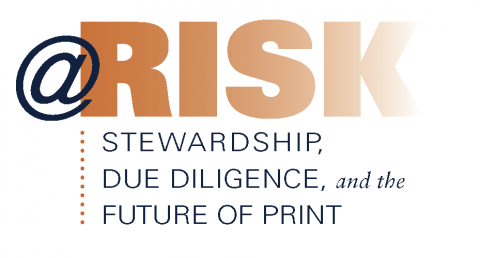Creating a “CRL consensus” on goals and standards is at the heart of CRL’s shared print agenda. Essential to establishing that consensus is CRL’s Collections and Services Policy Committee (CSPC). The committee was instrumental in the past in shaping the terms of CRL partnerships with the Linda Hall Library and the Law Library Microfilm Consortium, and they will similarly be involved in shaping terms with future partners.
Martha Hruska, chair, and other members of the committee have identified a number of areas in which our planning is still evolving. In the context of discussing the “sea change” the CSPC posed three questions, which I want to address in this blog post:
1. As CRL evolves from a single repository to a network of trusted partner repositories, who might be engaged in that network, and what trusted partner repositories are under consideration?
With the Linda Hall arrangement in place for STE serials, CRL is now focusing on the humanities and social sciences. It would be premature to name potential partners at this stage, but the profile of candidate organizations is certain. Major U.S. and Canadian research libraries and “libraries of record”, with deep and extensive HSS holdings, and that have longstanding commitments to comprehensive collecting, would be natural candidates to form the core of such a network. Cooperative shared print programs that can provide the requisite commitments to both archiving and providing electronic access to holdings would also be appropriate partners.
2. Would an academic/university library partnership have different characteristics than the Linda Hall arrangement, and if so, what long-term assurances should CRL put in place as the network expands?
CRL has maintained a high bar for collection stewardship. The long-term assurances we put in place with the Linda Hall Library arrangement are the subject of my post of March 10. Linda Hall is a unique institution, and brought special strengths to the partnership. Future arrangements will therefore likely differ from the Linda Hall arrangement, but the terms of stewardship will be no less stringent. As the network expands, CSPC must help determine how many distributed copies of a given serial are enough, how strong the commitments on archiving should be, to what extent archiving commitments should be audited, and what services archiving partners must provide. All of these terms will be structured to ensure a return to member libraries that is adequate to justify CRL’s investment.
3. How will CRL align its vision with its means, and what kind of business model will enable funding the costs of digitization and working with new partners? How does this affect CRL’s budget going forward?
There will be costs involved in further developing the shared collections, filling gaps in holdings, and digitization and hosting of shared materials. Therefore aligning vision with means will be critical to success. Throughout CRL’s history the organization has been, among other things, a mechanism for aligning action with resources. In keeping with that history a “CRL consensus” on standards and service will be a matter of CRL libraries deciding what they can and will support. CSPC will help us achieve that consensus.
There is a significant pool of resources (about $7 million/year) that CRL members now put toward the shared collections. To date we’ve done a great deal with that funding: we built, maintained and continued to provide access to a corpus of five million items, including about 50,000 serial titles. Through investment in the Linda Hall partnership we’ve been able to make another 40,000+ titles available. And we are digitizing about four million pages a year to provide electronic access to the shared collections.Given the state of public finances at both federal and state level, we don’t envision much additional funding becoming available for shared print. We therefore have to scale our aspirations to the level of resources the membership provides, grow that membership to support new capabilities, and form new partnerships that generate tangible new benefits for CRL libraries.
CRL has added new benefits and services for members in the past few years by drawing upon its reserve funds. We cannot do that indefinitely. Therefore we now propose to begin reallocating resources to new services from print and microform collections that are either not essential to CRL’s mission and those of diminishing value to members. This will enable us to shift the balance between CRL fixed assets (bricks and mortar, centralized collections) and liquid assets that are more conducive to expanding the shared collections and the services built around those collections.
Libraries face hard decisions. Guided by our Board of Directors, the Collections and Services Policy Committee, and CRL’s 209 voting member libraries we are forging community consensus on what is both desirable and affordable. That will be the topic of my report at the Council of Voting Members meeting on April 21. I encourage the representatives of all CRL voting member institutions to participate in the meeting.
